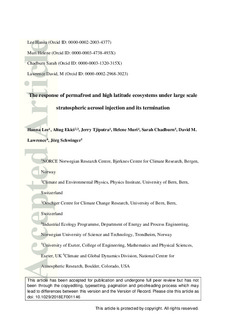| dc.contributor.author | Lee, Hanna | |
| dc.contributor.author | Ekici, Altug | |
| dc.contributor.author | Tjiputra, Jerry | |
| dc.contributor.author | Muri, Helene | |
| dc.contributor.author | Chadburn, Sarah E. | |
| dc.contributor.author | Lawrence, David M. | |
| dc.contributor.author | Schwinger, Jörg | |
| dc.date.accessioned | 2019-04-25T07:37:44Z | |
| dc.date.available | 2019-04-25T07:37:44Z | |
| dc.date.created | 2019-04-23T12:08:18Z | |
| dc.date.issued | 2019 | |
| dc.identifier.citation | Earth's Future. 2019, . | nb_NO |
| dc.identifier.issn | 2328-4277 | |
| dc.identifier.uri | http://hdl.handle.net/11250/2595367 | |
| dc.description.abstract | Climate engineering arises as one of the potential methods that could contribute to meeting the 1.5oC global warming target agreed under the Paris Agreement. We examine how permafrost and high latitude vegetation respond to large scale implementation of climate engineering. Specifically, we explore the impacts of applying the solar radiation management method of stratospheric aerosol injections (SAI) on permafrost temperature and the global extent of near‐surface permafrost area. We compare the RCP8.5 and RCP4.5 scenarios to several SAI deployment scenarios using the Norwegian Earth System Model (CE1: moderate SAI scenario to bring down global mean warming in RCP8.5 to the RCP4.5 level, CE2: aggresive SAI scenario to maintain global mean temperature toward the preindustrial level). We show that large scale application of SAI may help slow down the current rate of permafrost degradation for a wide range of emission scenarios. Between the RCP4.5 and CE1 simulations, the differences in the permafrost degradation may be attributed to spatial variations in surface air temperature, rainfall, snowfall, which lead to differences in the timing of permafrost degradation up to 40 years. Although atmospheric temperatures in CE1 and RCP4.5 simulations are similar, net primary production is higher in CE1 due to CO2 fertilization. Our investigation of permafrost extent under large‐scale SAI application scenarios suggest that circum‐Arctic permafrost area and extent is rather sensitive to temperature changes created under such SAI application. Our results highlight the importance of investigating the regional effects of climate engineering, particularly in high latitude ecosystems. | nb_NO |
| dc.language.iso | eng | nb_NO |
| dc.publisher | AGU Publication | nb_NO |
| dc.rights | Attribution-NonCommercial-NoDerivatives 4.0 Internasjonal | * |
| dc.rights.uri | http://creativecommons.org/licenses/by-nc-nd/4.0/deed.no | * |
| dc.title | The response of permafrost and high latitude ecosystems under large scale stratospheric aerosol injection and its termination | nb_NO |
| dc.type | Journal article | nb_NO |
| dc.type | Peer reviewed | nb_NO |
| dc.description.version | acceptedVersion | nb_NO |
| dc.source.pagenumber | 24 | nb_NO |
| dc.source.journal | Earth's Future | nb_NO |
| dc.identifier.doi | 10.1029/2018EF001146 | |
| dc.identifier.cristin | 1693434 | |
| dc.description.localcode | This is an open access article under the terms of the Creative Commons Attribution‐NonCommercial‐NoDerivs License, which permits use and distribution in any medium, provided the original work is properly cited, the use is non‐commercial and no modifications or adaptations are made. | nb_NO |
| cristin.unitcode | 194,64,25,0 | |
| cristin.unitname | Institutt for energi- og prosessteknikk | |
| cristin.ispublished | true | |
| cristin.fulltext | postprint | |
| cristin.qualitycode | 1 | |

